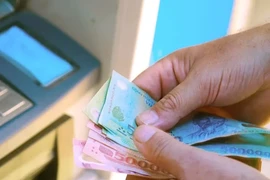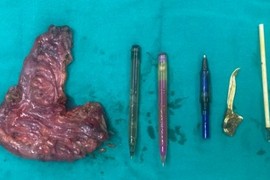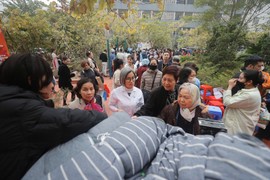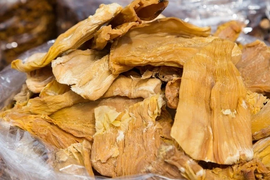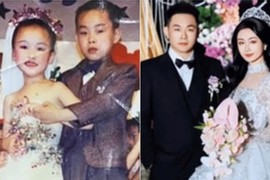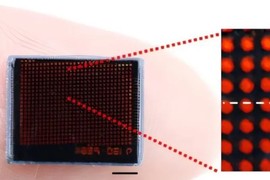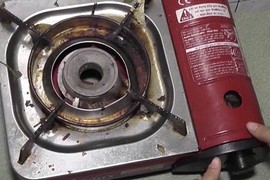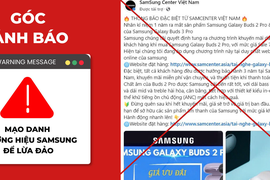 |
 |
 |
 |
| Hướng dẫn cách làm bài thi tuyển sinh ĐH FPT 2015 chi tiết từng phần. |
 |
 |
 |
 |
| Hướng dẫn cách làm bài thi tuyển sinh ĐH FPT 2015 chi tiết từng phần. |
Dưới đây là đề thi thử THPT quốc gia môn Vật lý năm 2015 do Đại học Sư phạm Hà Nội đưa ra. Đề thi gồm 50 câu trắc nghiệm, thời gian làm bài 90 phút.
Câu 1: Khi nói về biên độ của dao động tổng hợp, phát biểu nào sau đây sai? Dao động tổng hợp của hai dao động điều hòa cùng phương, cùng tần số có biên độ phụ thuộc vào
A. biên độ của dao động thành phần thứ nhất
B. biên độ của dao động thành phần thứ hai
C. tần số chung của hai dao động
D. độ lệch pha giữa hai dao động thành phần
Câu 2: Một vật nhỏ dao động điều hòa trên quỹ đạo dài 40cm. Khi qua li độ 10cm, vật có vận tốc bằng 20pi√3 cm/s. Chọn gốc thời gian lúc vật qua vị trí cân bằng theo chiều âm. Phương trình dao động của vật là:
 |
Câu 3: Con lắc lò xo treo thẳng đứng, dao động điều hòa với biên độ 8 cm và chu kì 0,4 s. Chọn trụ Ox thẳng đứng, chiều dương hướng xuống, gốc tọa độ tại vị trí cân bằng, gốc thời gian khi vật qua vị trí cân bằng theo chiều dương. Thời gian ngắn nhất kể từ đến khi lực đàn hồi của lò xo cực tiểu là
A. 4/15 s B. 7/30 s C. 3/10 s D. 1/30 s
Câu 4: Một vật dao động điều hòa với phương trình x = 6cos(ωt-pi)cm. Sau thời gian 1/30 s, vật đi được đoạn đường 9 cm. Số dao động vật thực hiện được trong mỗi giây là
A. 5 B. 10 C. 15 D. 20
Câu 5: Một quả cầu nhỏ bằng kim loại, tích điện C=5,66.10-6 C, khối lượng 10 g, được treo trên một sợi dây mảnh, cách điện, dài 1,4 m. Con lắc được đặt trong điện trường đều có phương nằm ngang, cường độ 104V/m, tại nơi có gia tốc trọng trường g=9,8 m/s2. Con lắc dao động nhỏ quanh vị trí cân bằng. Chu kì dao động của con lắc là
A. 2,21 s B. 2,37 s C. 2,12 s D. 2,47 s
Câu 6: Một quả cầu nhỏ khối lượng m=200g và một lò xo lí tưởng, chiều dài tự nhiên l0=24 cm, độ cứng k=49 N/m. Cho quả cầu dao động điều hòa với biên độ 4cm quanh vị trí cân bằng trên đường dốc chính của một mặt phẳng nghiêng ( góc nghiêng 300 so với phương ngang). Lấy g=9,8 m/s2, bỏ qua ma sát. Chiều dài lò xo biến đổi trong phạm vi
A. từ 20cm đến 28 cm B. từ 22 cm đến 30 cm
C. từ 24 cm đến 32 cm D. từ 18 cm đến 26 cm
Câu 7: Vật nhỏ khối lượng 200 g trong một con lắc lò xo dao động điều hòa với chu kì T và biên độ 4 cm. Biết trong một chu kì, khoảng thời gian vật nhỏ có độ lớn gia tốc không nhỏ hơn 500 √2 cm/s2 là T/2. Độ cứng lò xo là
A. 30 N/m B. 20 N/m C. 40 N/m D. 50 N/m
Câu 8: Vận tốc tức thời của một vật dao động là v=40pi.cos(5pi.t + pi/3)cm/s. Vào thời điểm nào sau đây vật sẽ đi qua li độ 4cm theo chiều âm của trục tọa độ?
A. 0,1 s B. 1/3 s C. 1/6 s D. 0,3 s
Câu 9: Một con lắc lò xo nằm ngang, dao động điều hòa. Cứ sau khoảng thời gian bằng 0,06 s, động năng của con lắc lại có giá trị bằng thế năng của nó. Biết lò xo có độ cứng 50 N/m. Khối lượng của vật nặng gắn với con lắc bằng
A. 72 g B. 18 g C. 48 g D. 96 g
Câu 10: Khi nói về dao động cưỡng bức, phát biểu nào đúng?
A. Dao động cưỡng bức có biên độ không đổi và có tần số bằng tần số ngoại lực cưỡng bức
B. Dao động cưỡng bức có tần số nhỏ hơn tần số của lực cưỡng bức
C. Biên độ dao động cưỡng bức là biên độ của lực cưỡng bức
D. Dao động của con lắc đồng hồ là dao động cưỡng bức
Câu 11: Một vật dao động điều hòa theo một trục cố định ( mốc thế năng tại vị trí cân bằng) thì
A. thế năng của vật cực đại khi vật ở vị trí biên
B. khi vật đi từ vị trí cân bằng ra biên, vận tốc và gia tốc cùng dấu
C. động năng của vật cực đại khi gia tốc của vật có độ lớn cực đại
D. khi đi qua vị trí cân bằng, gia tốc của vật có độ lớn cực đại.
 |
Câu 13: Một con lắc đơn gồm quả cầu kim loại nhỏ, khối lượng m, treo vào sợi dây mảnh có chiều dài l, trong điền trường đều E nằm ngang. Khi đó, vị trí cân bằng của con lắc tạo với phương thẳng đứng góc . So với khi chưa có điện trường, chu kì dao động bé của con lắc sẽ
A. tăng √2 lần B. giảm 2 lần
C. tăng 2 lần D. giảm √2 lần
Câu 14: Một vật nhỏ dao động điều hòa theo một trục cố định. Phát biểu nào đúng?
A. Quỹ đạo con lắc là một đoạn thẳng
B. Lực kéo về tác dụng vào vật không đổi
C. Quỹ đạo chuyển động của vật là đường hình sin
D. Li độ của vật tỉ lệ với thời gian dao động
Câu 15: Một vật khối lượng m, dao động điều hòa với phương trình x=Acos (ωt). Mốc thế năng ở vị trí cân bằng, cơ năng vật này bằng
A. 0,5m ω2A2 B. m ω2A C. 0,5m ωA2 D. 0,5m ω2A
Câu 16: Một vật dao động điều hòa với gia tốc cực đại 86,4 m/s2, vận tốc cực đại 2,16m/s. Quỹ đạo chuyển động của vật có chiều dài
A. 5,4 cm B. 10,8 cm C. 6,2 cm D. 12,4 cm

Câu 18: Cho một ống sao có một đầu bịt kín và một đầu để hở. Biết rằng ống sao phát âm to nhất ứng với hai họa âm liên tiếp là 150Hz và 250Hz. Tần số âm nhỏ nhất mà ống sao phát ra âm to nhất bằng
A. 50 Hz B. 75 Hz C. 25 Hz D. 100 Hz
Câu 19: Trên mặt thoáng của một chất lỏng có hai nguồn sóng A và B cách nhau 10cm, dao động cùng pha, cùng tần số 5 Hz. Gọi (∆) là đường trung trực của AB. Trên đường tròn đường kính AB, điểm mà trên đó dao động với biên độ cực tiểu cách (∆) một khoảng nhỏ nhất là 1,4cm. Tốc độ truyền sóng trên mặt chất lỏng là
A. 0,42 m/s B. 0,84 m/s C. 0,30 m/s D. 0,60 m/s
Câu 20: Đặt điện áp xiay chiều vào hai đầu đoạn mạch nối tiếp gồm tụ điện và điện trở R = 40 Ω thì điện áp giữa hai đầu đoạn mạch lệch pha pi/3 so với cường độ dòng điện trong đoạn mạch. Tổng trở của đoạn mạch bằng
A. 80 Ω B. 40 √3 Ω C. 80 √3 Ω D. 160 Ω
Câu 21: Phát biểu nào sau đây đúng với đoạn mạch xoay chiều nối tiếp?
A. Nếu chỉ biết hệ số công suất của đoạn mạch, ta xác định được điện áp giữa hai đầu mạch sớm pha hơn cường độ dòng điện qua đoạn mạch một góc bằng bao nhiêu?
B. Hệ số công suất của đoạn mạch càng lớn thì công suất tiêu thụ điện của mạch đó càng nhỏ
C. Cuộn cảm có thể có hệ số công suất khác không
D. Hệ số công suất của đoạn mạch RLC phụ thuộc vào các giá trị R, L và C, không phụ thuộc vào tần số của dòng điện trong mạch.
Câu 22: Đặt điện áp xoay chiều có giá trị hiệu dụng U vào hai đầu đoạn mạch RLC nối tiếp theo thứ tự. Điều chỉnh điện dung của tụ điện để điện áp hiệu dụng hai đầu tụ điện cực đại và có giá trị Uc = 2U. Điện áp hiệu dụng hai đầu đoạn mạch chứa R và L là
A. (√3/2)U B. √3U C. 2 √3U D. U

Câu 24: Phát biểu nào đúng khi nói về sóng cơ?
A. Biên độ sóng có thể thay đổi khi sóng lan truyền
B. Tốc độ truyền sóng phụ thuộc vào môi trường
C. Tốc độ truyền sóng trong chân không có giá trị lớn nhất
D. Bước sóng không đổi khi lan truyền qua các môi trường đồng tính
Câu 25: Ở bề mặt một chất lỏng có hai nguồn phát sóng kết hợp S1 và S2 cách nhau 19 cm. Hai nguồn dao động theo phương thẳng đứng với phương trình lần lượt là u1 = 5cos(40pi.t) mm và u2=5cos(40.pi.t+pi) mm. Tốc độ truyền sóng trên mặt chất lỏng là 80 cm/s. Số điểm dao động với biên độ cực đại trên đoạn nối hai nguồn là
A. 9 B. 10 C. 8 D. 11
Câu 26: Một sóng âm truyền trong thép với tốc độ 5820m/s. Nếu độ lệch pha của sóng âm đó ở hai điểm gần nhau nhất cách nhau 1,0m trên cùng phương truyền sóng là pi/3 thì tần số sóng bằng
A. 9700 Hz B. 1940 Hz C. 5820 Hz C. 970 Hz
 |
Câu 29: Đặt điện áp u=U0cos ωt vào hai đầu đoạn mạch chỉ có tụ điện C thì cường độ dòng điện trong mạch là i. Phát biểu nào đúng?
A. Ở cùng thời điểm, điện áp u chậm pha pi/2 so với cường độ i
B. Dòng điện i luôn ngược pha điện áp u
C. Ở cùng thời điểm dòng điện i chậm pha pi/2 so với điện áp u
D. Dòng điện i luôn cùng pha điện áp u
Câu 30: Một đoạn mạch điện xoay chiều gồm điện trở thuần R nối tiếp tụ điện C. Nếu dung khảng Zc bằng R thì cường độ dòng điện qua điện trở
A. nhanh pha pi/2 so với điện áp ở hai đầu đoạn mạch
B. nhanh pha pi/4 so với điện áp hai đầu đoạn mạch
C. chậm pha pi/2 so với điện áp ở hai đầu đoạn mạch
D. chậm pha pi/4 so với điện áp hai đầu đoạn mạch
Câu 31: Đặt điện áp xoay chiều có giá trị hiệu dụng 150V vào hai đầu đoạn mạch có R nối tiếp cuộn thuần cảm L. Điện áp hiệu dụng giữa hai đầu cuộn cảm là 120V. Hệ số công suất của đoạn mạch bằng
A. 0,6 B. 0,8 C. 0,7 D. 0,9
Câu 32: Âm do một chiếc đàn bầu phát ra
A. nghe càng trầm khi biên độ âm càng nhỏ và tần số âm càng lớn
B. nghe càng cao khi mức cường độ âm càng lớn
C. có độ cao phụ thuộc vào hình dạng, kích thước hộp cộng hưởng
D. có âm sắc phụ thuộc vào dạng đồ thị của âm
Câu 33: Ở mặt nước có hai nguồn sóng giống nhau A và B, cách nhau 12cm đang dao động theo phương vuông góc mặt nước, tạo ra sóng có bước sóng 1,2cm. M và N là hai điểm khác nhau thuộc mặt nước, cách đều hai nguồn và cách trung điểm I của AB 8cm. Số điểm dao động cùng pha A, B trên đoạn MN là
A. 5 B. 6 C. 7 D. 3
Câu 34: Tốc độ truyền sóng cơ phụ thuộc vào yếu tố nào sau đây?
A. Bản chất môi trường B. Bước sóng
C. Tần số sóng D. Năng lượng sóng
Câu 35: Gọi d là khoảng cách giữa hai điểm trên phương truyền sóng. Nếu d=(2n +1) v.T/2, n là các số tự nhiên, v là vận tốc truyền sóng, T là chu kì sóng thì hai điểm đó dao động
A. cùng pha B. ngược pha
C. vuông pha D. độ lệch pha không xác định
Câu 36: Trên một sợi dây căng ngang, hai đầu cố định có sóng dừng với tần số 5Hz. Biên độ dao động của điểm bụng sóng là 2cm. Khoảng cách gần nhất giữa hai điểm của hai bó sóng cạnh nhau có cùng biên độ 1 cm là 2 cm. Tốc độ truyền sóng trên dây là
A. 1,2m/s B. 0,6m/s C. 0,8m/s D. 0,4m/s
Câu 37: Một nguồn âm dược coi như nguồn điểm phát ra sóng âm trong một môi trường coi như không hấp thụ và phản xạ âm. Công suất của nguồn là 0,225V. Cường độ âm chuẩn là I0=10-12 W/m2. Mức cường độ âm tại điểm cách nguồn 10m là
A. 79,12 dB B. 83,45 dB C. 82,55 dB D. 81,25 bB
Câu 38: Một sóng ngang có phương trình u=5cos(8pi.t - 0,04pi.x) lan truyền trên dây rất dài, trong đó u và x đo bằng cm. Tốc độ truyền sóng trên dây là
A. 1 m/s B. 2,5 m/s C. 2 m/s D. 1,5 m/s
Câu 39: Cho đoạn mạch AB gồm R, L và C nối tiếp. Cuộn thuần cảm có độ tự cảm thay đổi được. Đặt vào hai đầu mạch điện áp u=100 √6cos(100pi.t) V. Điều chỉnh L để điện áp hiệu dụng hai đầu cuộn cảm cực đại thì điện áp hai đầu tụ điện là 200V. Giá trị điện áp hiệu dụng cực đại hai đầu cuộn cảm là
A. 150V B. 250V C. 300V D. 100V
Câu 40: Đặt điện áp u=U √2cos ωt vào hai đầu đoạn mạch RLC nối tiếp trong đó tụ điện có điện dung thay đổi được. Khi thì điện áp hiệu dụng hai dầu bản tụ có giá trị cực đại và điện áp hiệu dụng hai đầu R là 75V. Khi đso vào thời điểm điện áp tức thời hai đầu mạch bằng 75 √6V thì điện áp tức thời hai đầu đoạn mạch RL bằng 25 √6V. Điện áp hiệu dụng giữa hai đầu mạch bằng
A. 75 √6V B. 75 √3V C. 150V D. 152 √2 V
Câu 41: Cho đoạn mạch nối tiếp gồm điện trở R=60 Ω, tụ điện C và cuộn dây có độ tự cảm thay đổi được. Đặt vào hai đầu mạch điện áp 180V – 50Hz. Khi thay đổi độ tự cảm của cuộn dây tới giá trị mà cảm kháng cuộn dây là 30 Ω thì công suất tiêu thụ của đoạn mạch có giá trị lớn nhất, đồng thời uRC vuông pha với điện áp hai đầu cuộn dây. Công suất lớn nhất này bằng
A. 432W B. 192W C. 576W D. 216W

Câu 44: Đoạn mạch xoay chiều RLC nối tiếp có điện áp hiệu dụng hai đầu mạch không đổi. Hiện tượng cộng hưởng xảy ra khi
A. thay đổi tần số f để điện áp hiệu dụng hai đầu tụ cực đại
B. thay đổi điện dung C để công suất tiêu thụ của mạch cực đại
C. thay đổi điện trở R để công suất tiêu thụ của mạch cực đại
D. thay đổi độ tự cảm L để điện áp hiệu dụng hai đầu cuộn cảm cực đại
Câu 45: Một đoạn mạch dao động lí tưởng gồm cuộn thuần cảm L không đổi và tụ C có điện dung thay đổi. Điều chỉnh điện dung của tụ đến giá trị C1 thì tần số dao động riêng của mạch là f1. Để tần số dao động riêng của mạch là √5f1 thì phải điều chỉnh điện dung của tụ điện đến
A. 5C1 B. C1/5 C. √5C1 D. C1/ √5
Câu 46: Một đoạn mạch dao động lí tưởng gồm cuộn cảm L và tụ điện có điện dung C. Trong mạch đang có dao động điện từ tự do. Vào thời điểm t, dòng điện qua cuộn dây có cường độ bằng 0 thì ở thời điểm t+pi √LC
A. năng lượng điện trường của tụ điện có giá trị bằng nửa giá trị cực đại của nó
B. điện tích trên một bản tụ có giá trị bằng nửa giá trị cực đại của nó
C. điện tích trên tụ điện có giá trị bằng không
D. dòng điện qua cuộn dây có giá trị bằng không
Câu 47: Trong mạch dao động LC có dao động điện từ tự do với chu kì riêng là T thì
A. khoảng thời gian giữa hai lần liên tiếp năng lượng điện trường cực đại là T/2
B. năng lượng điện trường và năng lượng từ trường biến đổi tuần hoàn với chu kì T
C. khi năng lượng từ trường có giá trị cực đại thì năng lượng điện trường cũng có giá trị cực đại
D. khoảng thời gian giữa hai lần liên tiếp năng lượng lượng điện trường bằng năng lượng từ trường là T/2
Câu 48: Cho đoạn mạch LC lí tưởng có L=4 μH. Tại thời điểm t=0, dòng điện trong mạch có giá trị bằng nửa giá trị cực đại của nó và có độ lớn đang tăng. Thời điểm gần nhất ( từ t=0) để dòng điện trong mạch có giá trị bằng không là 5/6 μs. Điện dung của tụ điện bằng
A. 25 mF B. 25 nF C. 25 pF D. 25 μF
Câu 49: Một điểm trong không gian có sóng điện từ truyền qua , thì tại đó
A. vecto cảm ứng từ và vecto cường độ điện trường luôn cùng hướng với vecto vận tốc
B. cảm ứng từ và cường độ điện trường luôn lệch pha
C. cường độ điện trường và cảm ứng từ luôn dao động cùng pha
D. vecto cường độ điện trường và vecto cảm ứng từ luôn ngược hướng
Câu 50: Khi nói về cơ năng chất điểm dao động điều hòa, phát biểu nào sau đây sai? Cơ năng của chất điểm dao động điều hòa luôn bằng
A. tổng động năng và thế năng ở thời điểm bất kì
B. thế năng ở vị trí biên
C. động năng ở thời điểm ban đầu
D. động năng ở vị trí cân bằng
Kiến Thức sẽ giới thiệu đáp án của đề thi thử THPT quốc gia môn Vật lý này ở bài sau.
Dưới đây nguyên văn đề thi thử THPT quốc gia môn Anh văn năm 2015 của Trường THPT Yên Lạc. Đề thi gồm 80 câu trắc nghiệm.
Mark the letter A, B, C or D on your answer sheet to indicate the word that differs from the rest in the position of the main stress in each of the following questions.
Câu 1: A. secretary B. necessary C. classifies D. vocabulary
Câu 2: A. biology B. accordance C. incomplete D. putridity
Câu 3: A. ancient B. production C. sufficient D. deficient
Câu 4: A. parameter B. thermometer C. conscious D. speedometer
Câu 5: A. endangered B. humidity C. necessary D. incredible
Mark the letter A,B,C or D on your answer sheet to show the underlined part that needs correction.
Câu 6: Good clerks are happy to wait for their customers.
A. customers B. happy C. wait for D. Good clerks
Câu 7: Most everyone has a desire to succeed in life.
A. Most B. desire C. succeed D. has
Câu 8: His boss has asked him to respond immediately this fax.
A. His boss B. has C. to respond D. immediately
Câu 9: Every time he puts the toys away, the children just take it out again.
A. puts B. Every C. take it D. away
Câu 10: The children were playing last night outdoors when it began to rain very hard.
A. were playing B. very hard C. last night outdoors D. began
Câu 11: Although research has been ongoing since 1930, the existence of ESP-perception and communication without the use of the sight, hear, taste, touch or smell-is still disputed.
A. since B. existence C. hear D. use
Câu 12: As secretary of transportation from 1975 to 1977, William Coleman worked to help the bankrupt railroads in the northeastern United States solved their financial problems.
A. As B. to help C. solved D. financial
 |
| Ảnh minh họa. |
Câu 13: All nations may have to make fundamental changes in their economic, political, and
the technological institutions if they are to preserve environment.
A. have to make B. changes in
C. the technological institutions D. to preserve
Câu 14: Everyone attended the meeting accept the secretary.
A. Everyone B. secretary C. the D. accept
Câu 15: The company had to cut off the electric because the bill was unpaid.
A. cut off B. electric C. unpaid D. The
Mark the letter A, B, C or D on your answer sheet to indicate the correct answer to each of the following questions.
Câu 16: “I’d like to try on these shoes, please?” “ _____________ ”
A. That’s right, sir B. Why not? C. I’d love to. D. By all means, sir.
Câu 17: The Press thought the football manager would depress by his dismissal but he just ________.
A. ran it down B. laugh it off C. call it off D. turned it down
Câu 18: The criminal knows the ________ of successful robberies.
A. ins and outs B. trash and treasure C. close call D. part and parcel
Câu 19: I’m ____________ my brother is.
A. nothing as ambitious than D. nowhere near as ambitious as
B. nothing near as ambitious as C. nowhere like so ambitious
Câu 20: Your participation is ________ of the way we seek to involve everybody in our plans.
A. dependent B. desirous C. indicative D. integral
Câu 21: It ___________ able to finish it in an hour.
A. can’t have been too hard if you had been C. couldn’t be too hard if you are
B. can’t have been too hard if you were D. couldn’t be too hard if you had been
Câu 22: I do wish you’d stop biting your nail, Tom. It really _____________.
A. gets on my nerves B. tells me off C. lets me down D. gets me down
Câu 23: The floor was so rotten that it almost gave ________ under his weight.
A. way B. up C. back D. away
Câu 24: The organs of taste are the _____ that are mainly located on the tongue.
A. groups of cells are taste buds B. Taste buds are groups of cells
C. Taste buds, these are groups of cells D. Taste buds, groups of cells
Câu 25: Many a boy _________ come up with many new ideas.
A. have been B. has C. have D. has been
Câu 26: ________ you’ll be coming to the meeting next week since you prepared the documents?
A. Likely B. Predictably C. Presumably D. Surely
Câu 27: At the moment, we’re holding on to our shares, but ____ in value, we would probably sell them.
A. if they were rise B. for them to rise C. if only they rose D. were they to rise
Câu 28: _________________, he remained optimistic.
A. Though badly wounded he was C. As he was badly wounded
B. Badly wounded as he was D. As badly wounded he was
Câu 29: Hurricanes move with the large-scale wind currents _________ are imbedded.
A. that they B. which they C. in that they D. in which they
Câu 30: The classroom heating was broken and all the student sat there ________.
A. shivering B. sobbing C. dozing D. blushing
Câu 31: On the second level of the parking lot ____________________.
A. is empty B. are some empty stalls
C. some empty stalls are D. are empty
Câu 32: “Come on, Susan! Hurry up! Drink your milk.” “____________”
A. I can’t finish it. B. Yes, please. C. Forgive me. D. Excuse me.
Câu 33: The course seems to lay particular ______ on learning the theory behind the practice.
A. point B. mention C. highlight D. stress
Câu 34: Luisa does a full-time job and ______________.
A. looks after also the house C. look after the house too
B. look after the house either D. also look after the house
Câu 35: Lisa: “Have you been able to reach Peter?” Gina: “ __________ ”
A. Yes, I have known him for years. B. It’s much too high.
C. No, the line is busy. D. There’s no approval.
Read the following passage and mark the letter A,B,C or D on your answer sheet to indicate the correct word for each of the blanks from 36 to 45.
A couple who arranged a second wedding ceremony after photographs of the original ceremony
were ruined is claiming (36)_____from the photographer who captured their special day on film. The bride, Tracey Lloyd, burst into tears when she was given the initial (37)_____of her ‘big day’. Most of the photographs were out of focus and in some her face was actually obscured. She and her husband Gary are (38)_____in dispute with the company that took the wedding photographs. Two days after the ceremony, the Lloyds had to (39)_____the ceremony again with a different photographer. The final (40)_____was perfect, but they insist that the distress ruined their honeymoon. They have already (41)_____the offer of a refund of three hundred pounds. The new Mrs Lloyd said, ‘I was absolutely (42)_____. I couldn’t believe that it had happened to us after we had saved up for so long. It was supposed to be a perfect day, but the photographs were more like holiday snaps that had been taken by a real (43)_____. Her husband added, ‘The second set of pictures is excellent but the company gave the false (44)_____that everything went well the first time around. Now all those initial moments have passed. They are something you can never (45)_____.
Câu 36: A. compensation B. refunds C. damage D. repayments
Câu 37: A. copy B. record C. model D. likeness
Câu 38: A. currently B. at first C. momentarily D. at once
Câu 39: A. go over B. pass over C. go through D. pass through
Câu 40: A. work B. output C. effect D. product
Câu 41: A. dropped B. dismissed C. rejected D. denied
Câu 42: A. demolished B. overpowered C. overwhelmed D. devastated
Câu 43: A. apprentice B. newcomer C. trainee D. amateur
Câu 44: A. view B. impression C. interpretation D. opinion
Câu 45: A. take back B. take in C. bring in D. bring back
Read the following passage and mark the letter A,B,C or D on your answer sheet to indicate the correct answer to each of the questions from 46 to 55.
Watching for wildlife in the forest, we rarely see past the surface of things. Standing on the ground floor, we scan the leafy rafters, entirely overlooking the living world in the soil beneath out feet.
The forest‘s basement is a secret world. As different from our own world as water is from air, the soil seems quiet, even dead. But life bustles down below: a cubic inch of topsoil may contain billions of creatures.
Predators and prey roam beneath as well as above the forest floor. Furthermore, those upstairs and downstairs forest denizens live closely linked lives soil-dwelling bacteria and fungi break down deal organic matter into molecules that above ground plants use for food. Those plants, as well as animals, mature and die, leaving more organic matter to fuel the folks downstairs.
Like a well -insulated house, the soil protected its tenants from extreme temperatures, and from rain and snow. It also provides a bulwark against predators that roam the surface world. But the dense, protecting soil also limits mobility. Soil creatures must be specially equipped in order to travel easily through their dark, constricting realm.
Earthworms and ants are the champion earth-movers, creating channels that allow air and water to enter the soil. While
ants travel relatively far from their nests, earthworms work small areas, reprocessing vast amount of soil into fertile “waste”. In a single year, as much as 36 tons of soil may pass through the alimentary tracts of all the earthworms living in an acre of soil.
Câu 46: The main topic of the passage is_______ .
A. life in the forest soil B. the habitats of the forest animals
C. the life cycle of ants and worms D. a description of a forest scene
Câu 47: The word “ bustles” in the passage is closest in meaning to ________ .
A. is very active B. threatens C. continues. D. waits
Câu 48: It can be inferred from the passage that the forest soil is_____ .
A. sparsely inhabited B. devoid of life C. unknown to man D. densely inhabited
Câu 49: According to the passage, what is the main function of bacteria and fungi?
A. to build walls in the soil B. to help aerate the soil
C. to kill mature plants D. to provide food for plant life
Câu 50: The word “bulwark” in the passage is closest in meaning to_______ .
A. tomb B. radar C. barrier D. gateway
Câu 51: According to the passage, the soil offers creatures who live underground protection from all of the following EXCEPT__________.
A. bacteria and fungi B. bad weather
C. extreme heat and cold D. enemies
Câu 52: The word "constricting” can be replaced with _______.
A. deep B. heavy C. damp D. limiting
Câu 53: According to the passage, it could be expected that ants __________.
A. are more mobile than earthworms B. move more earth than earthworms
C. perform similar functions to fungi D. live only above ground
Câu 54: The word "reprocessing" in the passage is closest in meaning to
A. transporting B. converting C. eliminating D. arranging
Câu 55: The author uses which analogy to discuss the soil of the forest?
A. A building B. A vehicle C. A laboratory D. A tunnel
Read the following passage and mark the letter A,B,C or D on your answer sheet to indicate the correct answer to each of the questions from 56 to 65.
Experiments have shown that in selecting personnel for a job, interviewing is at best a hindrance, and may even cause harm. These studies have disclosed that the judgments of interviewers differ markedly and bear little or no relationship to the adequacy of the job applicants. Of the many reasons why this should be the case, three in particular stand out.
The first reason is related to an error of judgment known as the halo effect. If a person has one noticeable good trait, their other characteristics will be judged as better than they really are. Thus, an individual who dresses smartly and shows self- confidence is likely to be judged capable of doing a job well regardless of his or her real ability.
Interviewers are also prejudiced by an effect called the primacy effect. This error occurs when interpretation of later information is distorted by earlier connected information. Hence, in an interview situation, the interviewer spends most of the interview trying to confirm the impression given by the candidate in the first few moments. Studies have repeatedly demonstrated that such an impression is unrelated to the aptitude of the applicant.
The phenomenon known as the contrast effect also skews the judgment of interviewers. A suitable candidate may be underestimated because he or she contrasts with a previous one who appears exceptionally intelligent. Likewise, an average candidate who is preceded by one who gives a weak showing may be judged as more suitable than he or she really is.
Since interviews as a form of personnel selection have been shown to be inadequate, other selection procedures have been devised which more accurately predict candidate suitability. Of the various tests devised, the predictor which appears to do this most successfully is cognitive ability as measured by a variety of verbal and spatial tests.
Câu 56: This passage mainly discusses the _______.
A. judgments of interviewers concerning job applicants.
B. techniques that interviewers use for judging job applicants.
C. effects of interviewing on job applicants.
D. inadequacy of interviewing job applicants.
Câu 57: According to the passage the first impression _______.
A. is unrelated to the interviewer’s prejudices
B. is the one that stays with the interviewer
C. can easily be altered
D. has been repeatedly demonstrated to the applicant
Câu 58: The author mentions all of the following reasons why interviewing is not an accurate way to predict candidate suitability EXCEPT the _______.
A. cognitive effect B. contrast effect C. halo effect D. primacy effect
Câu 59: The word “hindrance” in paragraph 1 is closest in meaning to _______.
A. procedure B. interference
C. assistance D. encouragement
Câu 60: According to the passage, the “hallo effect” _______.
A. helps the interviewer’s capability to judge real ability
B. exemplifies how one good characteristic color perceptions
C. stands out as the worst judgmental error
D. takes effect only when a candidate is well -dressed
Câu 61: The word “they” in paragraph 2 refers to _______.
A. applicants B. characteristics
C. interviewers D. judgments
Câu 62: The word “confirm” in paragraph 3 is closest in meaning to _______.
A. recollect B. conclude
C. misrepresent D. verify
Câu 63: The word “skews” in paragraph 4 is closest in meaning to _______.
A. opposes B. distinguishes
C. improves D. biases
Câu 64: The word “ this” in last paragraph refers to _______.
A. devise accurate tests
B. devise personnel selection
C. predict candidate suitability
D. measure cognitive ability
Câu 65: The paragraphs following the passage most likely discuss which of the following?
A. More information on cognitive ability tests
B. Other reasons for misjudgments of applicants
C. Other selection procedures included in interviewing
D. More information on the kinds of judgmental effects
Mark the letter A, B, C or D on your answer sheet to indicate the sentence that is closest in meaning to the original sentence in each of the following questions.
Câu 66: Twice as many men as women are insurance agents.
A. More men than women have insurance.
B. Male insurance agents outnumber female agents.
C. Women are twice as likely as men to have insurance.
D. Insurance is twice as difficult to sell to women as to men.
Câu 67: Look out for those falling rocks!
A. Let’s look for falling rocks. B. Look out the window at those falling rocks.
C. Don’t let those falling rocks hit you. D. Look for these falling rocks.
Câu 68: Tim was humiliated by the whole experience.
A. Tim found the whole experience humiliated.
B. The whole experience was humiliating for Tim.
C. The whole experience made Tim humiliating.
D. Tim experienced something wholly humiliated.
Câu 69: Mark blew up when he heard the news.
A. Mark became curious when he heard the news.
B. Mark got angry when he heard the news.
C. Mark was worried when he heard the news.
D. Mark became nervous when he heard the news.
Câu 70: The government does not know what to do with household rubbish in large cities.
A. It is unknown what to do with household rubbish in large cities by the government
B. Rarely the government knows what to do with household rubbish in large cities.
C. Hardly any government knows what to do with household rubbish in large cities.
D. Little does the government know what to do with household rubbish in large cities.
Mark the letter A, B, C or D on your answer sheet to the best sentence which is made up from the given cue word.
Câu 71: number/ factor/ relate/ voice/ reveal/ personality/ speaker.//
A. A number of factors that related to the voice revealing the personality of the speaker.
B. A number of factors related to the voice reveal the personality of the speaker.
C. The number of factors related to the voice revealed the personality of the speaker.-
D. The number of factors relating to the voice revealed the personality of the speaker.
Câu 72: you/ entitle/ drive/ car/ your driving license. //
A. You are not entitled to driving a car without your driving license.
B. You do not entitle to drive a car without your driving license.
C. You are not entitled to drive a car with your driving license.
D. You are not entitled to drive a car without your driving license.
Câu 73: you / attend / work / stop / day-dream?
A. Would you please attend to your work and stop day-dreaming?
B. Would you please attend to your work and stop day-dream?
C. Would you attend your work and stop day-dreaming?
D. Do you attend to your work and stop day-dreaming?
Câu 74: actually / Jim / rather / not / go / class / yesterday / today.
A. Actually, Jim would rather not to go to class yesterday than today.
B. Actually, Jim would rather not have gone to class yesterday than today.
C. Actually, Jim would rather not going to class yesterday than today.
D. Actually, Jim would rather not to have gone to class yesterday than today.
Câu 75: legend/ that / tea/ beverage/ discover / 2737B.C.//
A. Legend said that tea was a beverage was discovered in 2737B.C.
B. Legend makes it that tea was a beverage discovered in 2737B.C.
C. Legend told it that tea as a beverage which discovered in 2737B.C.
D. Legend has it that tea as a beverage was discovered in 2737B.C.
Mark the letter A, B, C or D on your answer sheet to indicate the word or phrase that is CLOSEST in meaning to the underlined part in each of the following questions.
Câu 76: Regular use of this cream will help to relieve the rough, dry condition of your skin.
A. abbreviate B. abstract C. alleviate D. evaporate
Câu 77: Tourists today flock to see the two falls that actually constituteNiagara falls.
A. come by plane B. come in large numbers
C. come out of boredom D. come without knowing what they will see
Câu 78: After many year of unsuccessfully endeavoring to form his own orchestra, Glenn Miller finally achieved world fame in 1939 as a big band leader.
A. offering B. requesting C. trying D. deciding
Mark the letter A, B, C or D on your answer sheet to indicate the word or phrase that is OPPOSITE in meaning to the underlined part in each of the following questions:
Câu 79: The Red Cross is an international humanitarian agency dedicated to reducing the sufferings of wounded soldiers, civilians and prisoners of war.
A. worry and sadness B. happiness C. loss D. pain and sorrow
Câu 80: They have not made any effort to integrate with the local community.
A. connect B. cooperate C. put together D. separate


